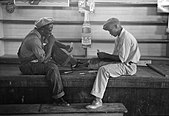Conquian
Conquian , also Conquain , Coon Can , Coon King is a historical card game for two people. Conquian is considered to be the ancestor of the games of the rummy family; Conquian probably originated in Mexico around 1890 , made it to the south of the United States and spread from there.
Conquian has been almost superseded by its various descendants - in the USA especially by gin rummy - but it is still partly played today.
The rules
Conquian was originally played with Spanish playing cards , later with a French hand without the values 8, 9, 10, i.e. with 40 cards.
Before starting the first game, each player draws a card. Whoever draws the lower card is the first divider, then the division changes after each game.
Each player receives ten cards, the remaining cards are placed in a pile in the middle.
The aim of the game is to lay out eleven cards in reports (see Gin Rummy - Card Combinations ).
The non-divider starts the game by serving the top card of the pile. If he can use it to form a figure, he interprets it; otherwise he offers the open card to his opponent. Should this also not be able to form a figure with the card, then the card is put aside face down and the divider now opens the top card of the pile.
If a player puts out one or more messages, he ends his turn by laying down a card face up. The opponent can pick up this card and use it in a report or reveal the top card of the pile.
In this way, play continues until either a player has reported eleven cards or the pile is exhausted.
A player may combine cards from his own displayed messages (similar to Rummy - Robber Rummy ) in order to be able to display more cards ( borrowing ).
A player may discard a card, although he could place it on his own message, but the opponent can force him to place the card ( forcing ). Likewise, if a player discards a card that the opponent can put on one of his reports, he can force him to buy the discarded card and put it on.
A player has won as soon as he has reported eleven cards, if he has only reported ten cards, he must continue to play without holding a card in his hand.
If the stroke is used up before a player can win the game, the game is a tie and it is re-divided.
The winner receives a token from the loser ; if a game is tied, the next game is a double bet.
literature
German-language literature
- Claus D. Grupp: Rummy and Canasta in all variations , Falken-Verlag Niedernhausen / Ts, 1982
- Rudolf Heinrich [d. i. Rudolf Bretschneider]: Rummy - Rummy international Alle Spielarten , Verlag Perlen-Reihe , Volume 650, 7th edition, Vienna 19 ??
English-language literature
- The United States Playing Card Company, Joli Quentin Kansil, Editor: Official Rules of Card Games , 90th Edition, 2004
- Albert H. Morehead, Richard L. Frey, Geoffrey Mott-Smith: The New Complete Hoyle Revised , Doubleday, New York, 1991
- David Parlett : Oxford Dictionary of Card Games , Oxford University Press Oxford New York 1992/96
- David Parlett: The Oxford Guide to Card Games , Oxford University Press Oxford New York 1990
- John Scarne : Scarne on Card Games , New York 1949/65, Courier Dover Publications Reprint 2004
